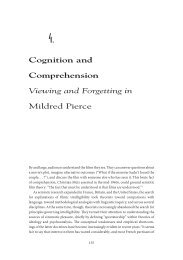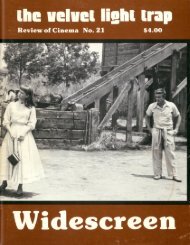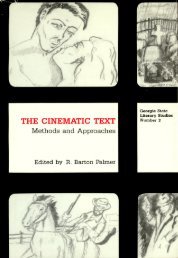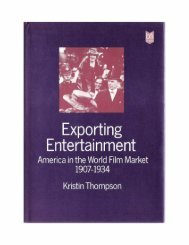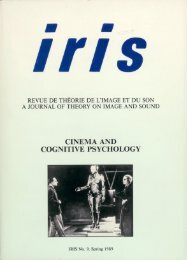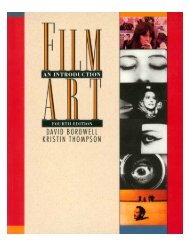a NORTH BY NORTHWEST - David Bordwell
a NORTH BY NORTHWEST - David Bordwell
a NORTH BY NORTHWEST - David Bordwell
You also want an ePaper? Increase the reach of your titles
YUMPU automatically turns print PDFs into web optimized ePapers that Google loves.
3661 FILM CRITICISM: SAMPLE ANALYSES<br />
telephones thus constitute a communications network that permits the nar-<br />
rative to be relayed from point to point.<br />
But Hawks also visually and sonically orchestrates the characters' use<br />
of the phones. There are many variations. One person may be talking on<br />
the phone, or several may be talking in turn on different phones, or several<br />
may be talking at once on different phones, or a phone conversation may<br />
he juxtaposed with a conversation elsewhere in the room, and so on. In<br />
scene 11, there is a polyphonic effect of reporters coming in to phone their<br />
editors, each conversation overlapping with the preceding one. Later, in<br />
scene 13, while Hildy frantically phones hospitals, Walter screams into<br />
another phone. And when Bruce returns for Hildy, a helter-skelter din arises<br />
that eventually sorts itself into three soundlines: Bruce begging Hildy to<br />
listen, Hildy obsessively typing her story, and Walter yelling into the phone<br />
for Duffy to clear page one ("No, no, leave the rooster story-that's human<br />
interest!"). Like much in His Girl Friday, the telephones warrant close study<br />
for the complex and various ways in which they are integrated into the<br />
narrative, and for their contribution to the rapid tempo of the film.<br />
STAGECOACH<br />
1939. W ter Wanger Productions (released through United Artists). Directed<br />
by John Ford. Script by Dudley Nichols, from the short story "Stage to<br />
Lordsburg" by Ernest Haycox. Photographed by Bert Giennon. Edited by<br />
Dorothy Spencer and Walter Reynolds. Music by Richard Hageman, W.<br />
Franke Harling, John Leipold, Leo Shuken, Louis Gruienberg. With John<br />
Wayne, Claire Trevor, Thomas Mitchell, Andy Devine, George Bancroft, Don-<br />
ald Meek, Louise Platt, John Carradine, Berton Churchill.<br />
Film theorist And& Bazin has written of John Ford's Stagecoach: "Stage-<br />
coach (1939) is the ideal example of the maturity of a style brought to<br />
classic perfection. . . . Stagecoach is like a wheel, so perfectly made that<br />
it remains in equilibrium on its axis in any position." This effect results<br />
from the film's concentration on the creation of a tight narrative unity, with<br />
all of its elements serving that goal.<br />
As in His Girl Friday, the narrative consumes a short stretch of story<br />
time-two days. The plot takes the word "Stage~oach'~ (a coach traveling in<br />
stages, stopping along the way) literally and makes this the basis of its<br />
narrative divisions. The film's action consists of the progression of a stagecoach<br />
from its starting point to its destination, with the major scenes<br />
occurring at the places where the coach stops for meals and rest. Instead<br />
of a detailed segmentation of the film, a broader breakdown of the largescale<br />
parts of the journey lets us bring out important aspects of the form's<br />
development:<br />
First day<br />
1. Cavalry receives word of Indian uprising.<br />
2. In Tonto, the passengers board the stagecoach.<br />
3. Conversations during the first part of the journey.<br />
4. First stage stop: noon dinner and the word that there will be no escort.
5. Conversations during the second part of the journey.<br />
6. Second stage stop: night. Lucy's baby is born; Ringo proposes to<br />
Dallas.<br />
Second day<br />
'7. Morning: departure from the second stage stop.<br />
8. Conversations during the third part of the journey.<br />
9. Third stage stop: passengers discover burned ferry, float coach across<br />
river, are attacked and chased by Indians, and are rescued by the<br />
cavalry.<br />
10. Arrival at Lordsburg; Ringo meets the Plurnrner brothers in a shoot-<br />
out*<br />
11. Ringo and Dallas depart for Ringo7s ranch.<br />
The perfect balance of one part against another is apparent in this<br />
outline. At the very beginning and end, short scenes take place among the<br />
buttes of Monument Valley. Initially we see the cavalry riding and bringing<br />
the news that Geronimo is on the warpath. At the end, a single shot shows<br />
Ringo and Dallas riding through the valley toward their new life together.<br />
The film's second part takes place in the town of Tonto, where the passengers<br />
board the coach. The journey ends in Sequence 10, which reverses the<br />
second part; here the passengers disembark in Lordsburg, their destination.<br />
Here also the various goals these characters had set up for themselves are<br />
resolved.<br />
Between these two points of departure and arrival, there are three<br />
sequences of travel along the road (parts 3, 5, and 8), each culminating in<br />
the arrival at one of the three stages, or stops, along the way. During the<br />
first stop, at Dry Fork, the passengers eat their noon meal. At the second,<br />
Apache Wells, they spend the night. The departure the next morning<br />
parallels the previous day's departure from the town; the pattern of parts<br />
5-6 repeats that of parts 3-4.<br />
As before, the departure scene leads to a new traveling phase, part 8.<br />
But after two repetitions of the travel-stage-stop pattern, the narrative<br />
introduces a major variation. When the coach arrives at the outpost for the<br />
third and final stage, East Ferry, the characters find it burnt by Indians.<br />
The coach crosses the river and goes on toward Lordsburg, but our expec-<br />
tation of a major scene at this point is not disappointed. In the formal<br />
position of the third stage stop, the Indians attack. After the chase and<br />
rescue, an ellipsis moves the narrative directly to Lordsburg, eliminating<br />
the last part of the journey.<br />
The initial departure from Tonto (Segment 2) establishes the goals of<br />
most of the characters. Lucy Mallory is traveling to join her husband, who<br />
is in the cavalry. Mr. Peacock, a whiskey salesman, is on his way home to<br />
join his wife in Kansas City. The two leaders of the group are the driver,<br />
Buck, who also is going home to his family in Lordsburg, and the marshall,<br />
Curly, who goes along as guard to try to capture the Ringo Kid.<br />
Two "'undesirables"--Doc Boone, the local drunk, and Dallas, a pros-<br />
titute--leave town on the same stagecoach, driven out by the "respectable"<br />
THE CLASSICAL NARRATIVE CINEMA 1367
3681 FILM CRITICISM: SAMPLE ANALYSES<br />
elements of the town. Doc and Dallas have no definite goal, except to find<br />
a place where they will be allowed to stay. The gambler, Hatfield, also joins<br />
the group with no long-term goal of his own; he seeks to protect Lucy<br />
Mallory on her journey.<br />
The narrative emphasizes two characters by having them board the<br />
coach later. Having stolen the payroll money deposited in his bank, Gate-<br />
wood hails the coach on the street and gets in. Catewood's purpose is to<br />
escape undetected. A short while after the coach leaves Tonto, it meets<br />
Ringo, who wants to get to Lordsburg to avenge himself on the Plummer<br />
brothers. He joins the group, under arrest by Curly.<br />
Most of the significant causal developments in the plot come in the<br />
scenes at the two stage stops. In the first (Segment 4), the seating pattern<br />
at the table defines the social relationships. Within the group, Ringo and<br />
Dallas are both shunned as outcasts and hence are thrown together. Mr.<br />
Peacock defines himself as the weakling of the group by being the only one<br />
to vote to return to Tonto when they discover that no cavalry escort will be<br />
available beyond that stop.<br />
The second stage stop (Segment 6) is the most important scene during<br />
the journey for its development of character relationships. Doc Boone and<br />
Dallas, the two undesirables, earn the admiration of the others by helping<br />
deliver Lucy's baby. At this point Ringo proposes marriage to Dallas.<br />
Between the major sequences in the towns, the stages, and the Indian<br />
attack come three sequences of traveling through Monument Valley (parts<br />
3, 5, and 8), each consisting of a number of similar short scenes. Each<br />
scene begins with a long shot or extreme long shot of the coach, often<br />
accompanied by the distinctive "stagecoach" musical motif. Several times,<br />
especially early in each sequence, this long shot is followed by a medium<br />
shot of the driver's seat, with Curly and Buck talking. These shots give<br />
snatches of exposition. For example, we learn that Curly is sympathetic to<br />
Ringo's revenge motives and that he is suspicious of Gatewood.<br />
Each short scene also contains one or more shots inside the coach,<br />
with the passengers making conversation or exchanging glances. These<br />
interchanges tend to reestablish character traits and relations rather than<br />
move the action forward. Gatewood complains constantly; Boone filches<br />
drinks from Peacock's sample bag; Hatfield courteously assists Lucy's com-<br />
fort. Several motifs enter into these characterizations. Boone's liquor con-<br />
trasts with the canteen the women drink from, and the two valises belonging<br />
to Gatewood and Peacock also set up a contrast. The development of the<br />
characters' attitudes toward one another is also apparent. Before the birth<br />
of Lucy's baby, the other characters ignore Dallas; in later scenes they are<br />
relatively kind to her. I<br />
These numerous short scenes, strung together within the travel se-<br />
quences, function to give a sense of the coach's progression. Dissolves link<br />
most of them, indicating the passage of time and the movement through<br />
space. Unlike His Girl Friday, Stagecoach has almost no scenes that end<br />
with dangling causes that "hook7' over into the beginning of the next scene.<br />
Causes are introduced, but these tend to disappear for long stretches of the<br />
action. Thus early in the film Curly mentions that he sympathizes with<br />
Ringo's desire for revenge. This sympathy emerges only in the final scene,<br />
in which Curly lets Ringo go have his shoot-out with the Plumrners. Because
most or all of the nine characters are present in almost every scene of the<br />
journey, Stagecoach has little need for dangling causes. The coach's journey<br />
itself provides the forward development of the action.<br />
Much of the richness of Stagecoach's narrative comes from the mixing<br />
of numerous characters with separate, sometimes contradictory goals. The<br />
rapid resolutions of the characters' goals on the arrival at Lordsburg give a<br />
strong sense of closure. Lucy learns that her husband, reported to have<br />
been wounded by Indians, is safe; Peacock survives his wound; Gatefield<br />
is arrested. Thus most of the strongly positive and negative characters are<br />
taken care of.<br />
Other characters have had to prove their worth in the course of the<br />
action. Hatfield ie a notorious gambler but proves himself to be a "gentle-<br />
man" by protecting Lucy and dying in the battle with the Indians. Doc<br />
Boone has sobered up in order to deliver Lucy's baby; he also stands up to<br />
the Plummers in the tavern before the shoot-out. Indeed, at the end of the<br />
film the marshal offers Boone a drink. He replies, "Just one:' suggesting<br />
that even he has been somewhat changed by his experiences on the trip.<br />
The last section of the narrative focuses primarily on the fates of Dallas<br />
and Ringo. Of all the passengers Ringo was the last to enter the action.<br />
Now his goal of revenge determines the last portion of the plot, after most<br />
of the other characters have gone their ways. Dallas, who had no definite<br />
goal of her own, has gained one in her love for Ringo. His victory over the<br />
Plummers and the marshal's decision not to send him back to jail lead to<br />
the final resolution. Both Dallas and Ringo go free to start their new life<br />
together. The final long shot of their wagon moving along the road through<br />
Monument Valley recalls the beginning and the many long shots of the<br />
coach.<br />
The style of Stagecoach helps create the repetitions and variations of<br />
this narrative action. We have indicated the repeated pattern of establishing<br />
long shots of the coach, interspersed with closer shots within the coach;<br />
these latter shots pick up the eyelines and gestures of the characters'<br />
conversations. We have already analyzed one outstanding use of offscreen<br />
sound in Stagecoach, in Chapter 8 (p. 309); you might examine other uses<br />
of sound in the film, along with their functions.<br />
The film's use of deep space and deep focus is particularly outstanding.<br />
As we shall see in more detail in Chapter 11, the style of filming in<br />
Hollywood during the 1930s was generally a "shallow-," or "soft-focus"<br />
style. A few American films in the late 1930s began to experiment with<br />
deep focus, and Stagecoach was one of them. A number of shots in the<br />
second stage-stop sequence use deep focus along the corridor outside Lucy's<br />
room, as when Ringo watches Dallas go out into the yard (Fig. 10.1) or<br />
outside when he follows her (Fig. 10.2). Welles claimed to have watched<br />
Stagecoach many times before making Citizen Kane, the film usually credited<br />
with having introduced deep-focus photography; the similarities of lighting,<br />
mise-en-scene, and camera manipulations are apparent from these stills.<br />
Ford's cinematographer used wide-angle lenses to keep several planes in<br />
focus and to exaggerate perspective. The deep-focus shots make use of<br />
strong backlighting, which picks out Dallas and Ringo in the dark hallway<br />
and yard. The lighting is very different from the flat lighting used in most<br />
other scenes. This pattern of patches of light in darkness returns again in Fig. 10.2<br />
THE CLASSICAL NARRATIVE CINEMA 1369
Fig. 10.4<br />
the Lordsburg sequence, when the plans the couple has made at the stage<br />
stop are finally made possible.<br />
On the whole, Ford's editing style remains within the Hollywood continuity<br />
system. But it is worth noting that Stagecoach's editing is not always<br />
as "perfectly classical" as Bazin maintains. For example, the Indian attack<br />
violates screen direction. At times the coach and Indians move across the<br />
screen from left to right. At others they move right to left. Sometimes Ford<br />
uses a heads-on or tails-on shot to cross the line, in the accepted manner,<br />
but at other times he does not. At one point, Ringo starts to leap down onto<br />
the houses' backs to retrieve a lost rein. His leap begins - in medium long -<br />
shot, from right to left (Fig. 10.3). In the next shot he is moving left to<br />
right (Fig. 10.4).<br />
These deviations show that violations of continuity rules do not always<br />
confuse the audience. The narrative context tells us that there is only one<br />
coach and one band of Indians chasing it in a straight line across a flat<br />
desert. As long as the filmmaker has sufficiently established the space and<br />
the moving elements, changes in screen direction should not be perplexing.<br />
It is usually only when we are uncertain about who is present and where '<br />
the figures are in relation to one another that the violation of screen direction<br />
becomes confusing.<br />
In spite of such lapses, Stagecoach remains an outstanding example<br />
of that classical unity of form and style that Bazin ide~~tified with 1930s<br />
Hollywood. Our discussions of North by Northwest, Hannah and Her Sisters,<br />
and Desperately Seeking Susan will show that this tendency has continued<br />
to the present.<br />
a <strong>NORTH</strong> <strong>BY</strong> <strong>NORTH</strong>WEST<br />
1959. MGM. Directed by Alfred Hitchcock. Script by Ernest Lehman. Pho-<br />
tographed by Robert Burks. Edited by George Tornasini. Music composed by<br />
Bernard Hermann. With Cary Grant, Eva Marie Saint, James Mason, Leo 6.<br />
Carroll, Jesse Royce Landis.<br />
Hitchcock long insisted that he made thrillers, not mystery films. For him,<br />
creating a puzzle was less important than generating suspense and surprise.<br />
While there are important mystery elements in films like Notorious (1946),<br />
Stage Fright (1950), and Psycho (1960), North by Northwest stands as<br />
almost a pure example of Hitchcock's belief that the mystery element can<br />
serve as merely a pretext for intriguing the audience. The film's tight causal<br />
unity enables Hitchcock to create an engrossing plot that obeys the norms<br />
of classical filmmaking. This plot is presented through a narration that<br />
continually emphasizes suspense and surprise.<br />
Like most spy films, North by Northwest has a complex plot, involving<br />
two major lines of action. In one line, a gang of spies mistakes advertising-<br />
agency executive Roger Thornhill for an American agent, George Kaplan.<br />
Although the spies fail to kill him, he becomes the chief suspect in a murder<br />
which the gang commits. He must flee the police while trying to track down<br />
the real George Kaplan. Unfortunately, Kaplan does not exist; he is only a<br />
decoy invented by the United States Intelligence Agency (USIA). Thornhill's



